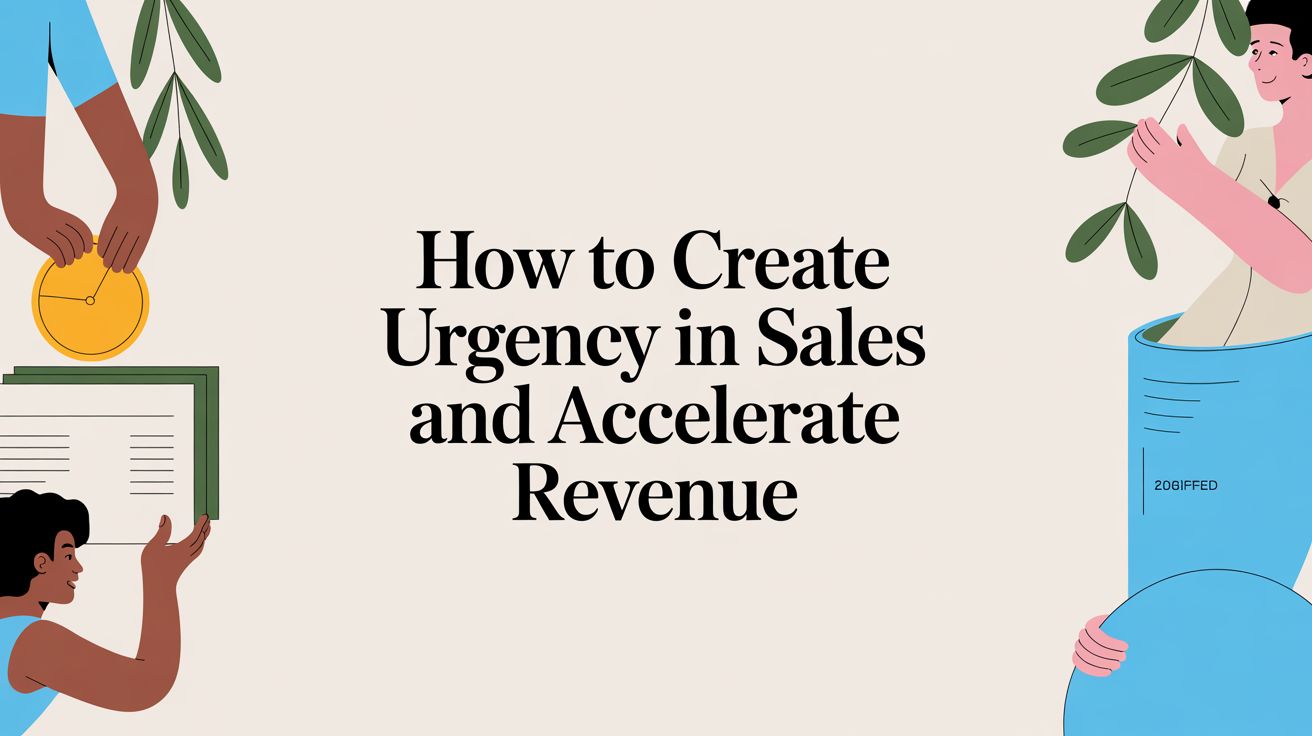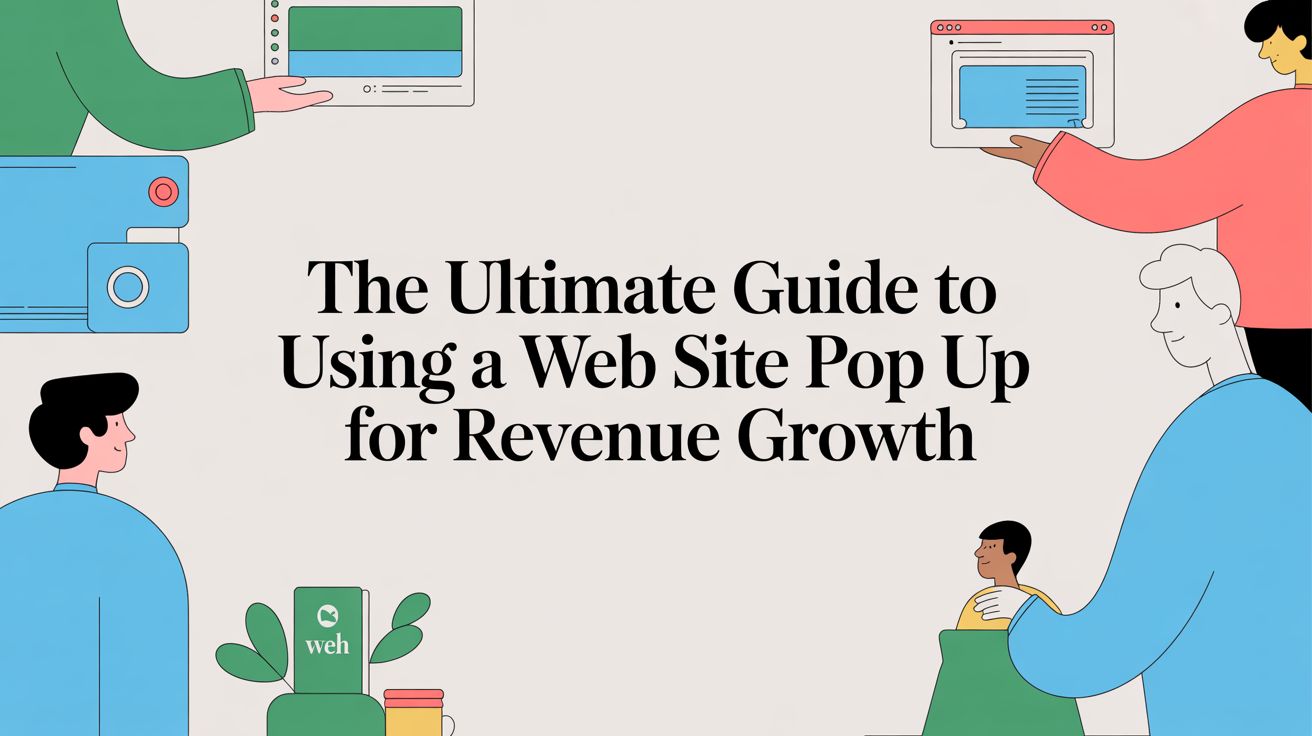
Choosing Your Ecommerce Marketing Platform: A Guide to Driving Revenue
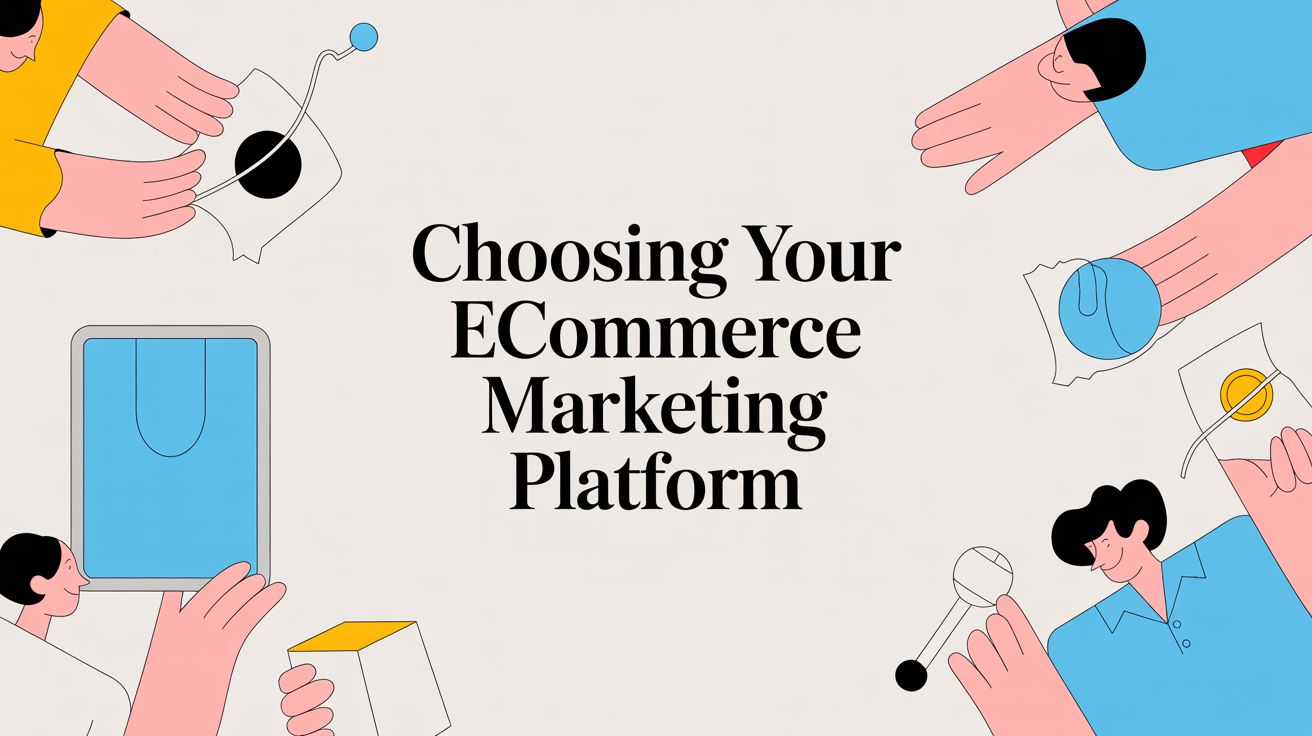
An ecommerce marketing platform is the central nervous system for your online store's growth. It's a single system that integrates your marketing channels—email, SMS, ads, on-site experiences, and analytics—and orchestrates them into a cohesive, revenue-driving machine. This unified approach allows you to see, understand, and manage the entire shopper journey, from first click to repeat purchase.
What Is an Ecommerce Marketing Platform?
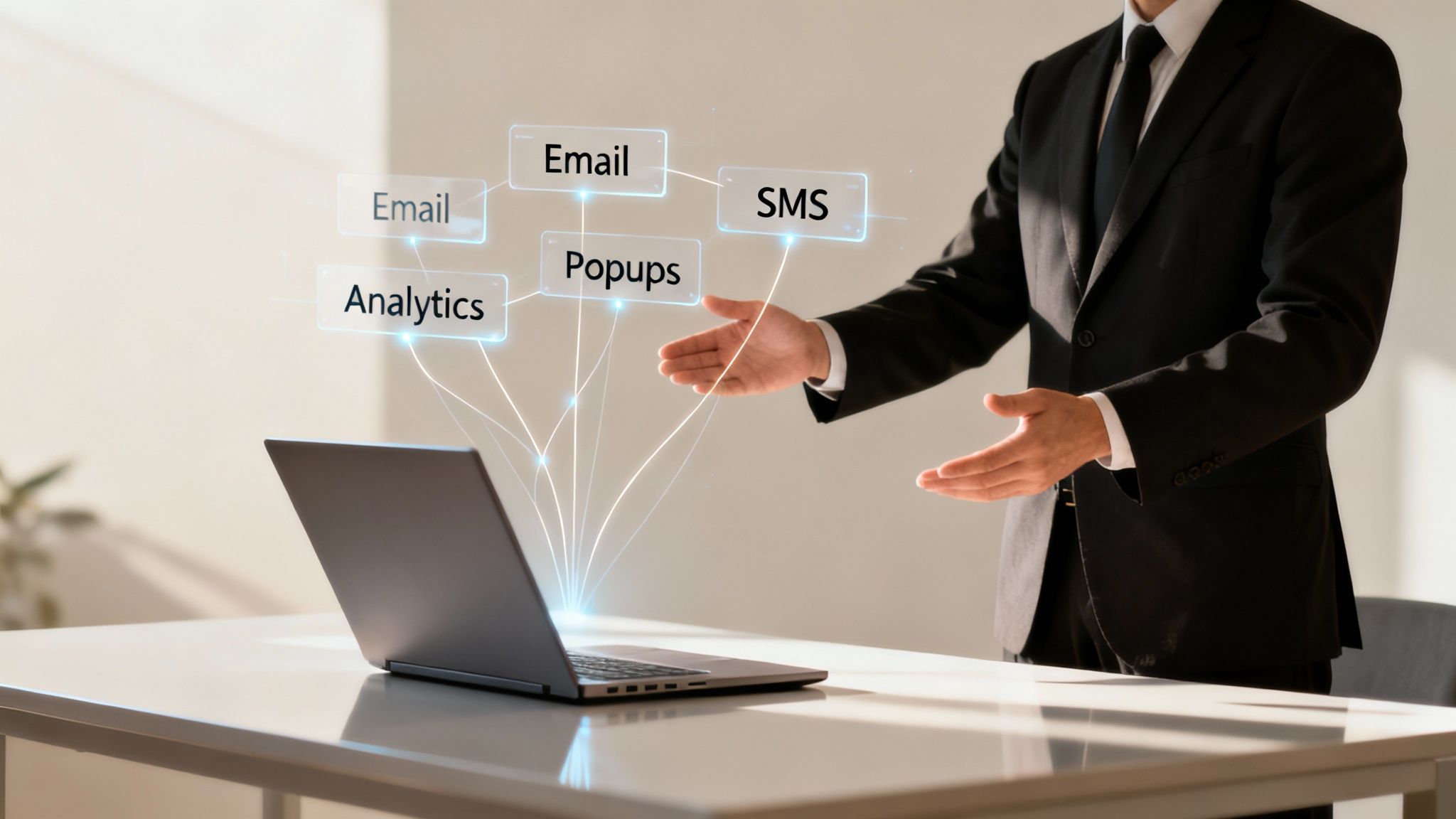
An ecommerce marketing platform is a software solution that centralizes a brand's marketing tools, customer data, and automation workflows into one command center. It eliminates the data silos that occur when using disconnected apps for email, SMS, and popups, enabling a brand to execute sophisticated, multi-channel campaigns based on a unified view of customer behavior.
Think of your marketing tools as talented musicians. Your email service is a skilled violinist, your SMS provider a powerful percussionist, and your popup app a nimble flutist. Separately, they perform well. But without a conductor, you get noise, not a symphony.
An ecommerce marketing platform is that conductor. It harmonizes every channel to create a seamless, compelling experience for your shoppers.
This integration is critical because it breaks down data silos. When your tools aren't communicating, you have a fragmented picture of your customer. Your email campaign doesn't know a shopper just received an SMS message, leading to inconsistent messaging and missed revenue opportunities. A unified platform ensures every touchpoint is informed by a complete customer profile.
The Impact on Revenue and Operations
By consolidating your data and workflows, an ecommerce marketing platform has a direct impact on your bottom line and operational efficiency. Instead of juggling a dozen subscriptions and wrestling with fragile integrations, your team can focus on strategy and execution. This operational efficiency is a game-changer, especially for growing brands where manual campaign management becomes a significant bottleneck.
The benefits extend far beyond saving time—they are about generating smarter, more profitable revenue.
A high-impact platform empowers you to:
- Automate Complex Workflows: Set up triggers for personalized messages based on specific customer behaviors, such as viewing a product three times without purchasing.
- Improve Customer Segmentation: Group customers based on their entire history with your brand, not just channel-specific data. This makes your campaigns far more relevant and effective.
- Gain Clearer Analytics: Finally understand which channels and messages are truly driving sales, enabling you to allocate your budget for maximum ROI and protect profit margins.
The shift from a patchwork of disconnected apps to a single, unified system is what separates the most successful modern ecommerce brands from the rest. The demand for these integrated solutions is fueling a booming market projected to hit USD 45.60 billion by 2033.
To give you a clearer picture, let's break down the essential jobs an ecommerce marketing platform handles.
Core Functions of an Ecommerce Marketing Platform
| Function | Business Impact |
|---|---|
| Data Consolidation | Gathers all customer data (browsing, purchase, engagement) into a single profile for a 360-degree view. |
| Marketing Automation | Triggers personalized emails, SMS, and other messages based on customer behavior, saving time and increasing relevance. |
| Audience Segmentation | Creates dynamic customer groups based on shared attributes or actions for highly targeted campaigns. |
| Multi-Channel Campaigning | Executes and coordinates marketing efforts across email, SMS, social ads, and on-site popups from one place. |
| Analytics & Reporting | Provides clear, unified dashboards to track campaign performance, customer lifetime value, and overall ROI. |
These core functions work in concert to turn siloed data into coordinated, revenue-generating actions.
Moving Beyond Basic Tools
Ultimately, an ecommerce marketing platform is about graduating from reactive marketing to proactive, automated engagement. It enables you to run sophisticated strategies that protect your profit margins and help you manage inventory more effectively.
For example, instead of blasting out a generic, margin-killing discount to everyone, you can orchestrate targeted promotions to specific segments who need a gentle nudge. For a deeper look at this, check out our guide on marketing automation for small businesses.
This strategic approach is what separates high-growth brands from those stuck trying to manage a chaotic collection of standalone tools.
Key Features of a High-Impact Platform
When evaluating an ecommerce marketing platform, it's easy to get lost in feature checklists. To see real ROI, you need more than a list of capabilities. You need a system built on a deep understanding of consumer psychology and behavior.
The best platforms don't just send emails; they create a smart, unified marketing engine that powers growth, especially for ambitious brands on Shopify and Shopify Plus.
This engine runs on one crucial component: the Unified Customer Profile. Think of it as a living dossier on every shopper. It doesn’t just store an email address; it actively tracks every interaction—every click, every abandoned cart, every purchase, and every SMS reply. This 360-degree view is the foundation for creating the personal experiences that turn one-time buyers into loyal advocates.
Once you have this unified data, you can move beyond generic blasts and into sophisticated, multi-channel automation that drives revenue.
Advanced Behavioral Segmentation
This is where the real business impact happens. A high-impact platform lets you segment your audience based on nuanced behavioral triggers, not just static demographics. It's the difference between shouting a generic discount and whispering a perfectly-timed, personal offer when it matters most.
With effective segmentation, you can finally:
- Identify High-Intent Shoppers: Automatically group customers who've viewed a specific product three times this week but haven't bought. That's a high-value segment ready for a targeted nudge.
- Prevent Cart Abandonment: With industry cart abandonment rates hovering around 70%, triggering a timely SMS or push notification sequence the moment a shopper leaves a full cart is a direct line to revenue recovery.
- Reward Loyal Customers: Build exclusive segments for your top spenders. Grant them early access to new collections, exclusive promotions, or a simple thank-you offer.
Trying to do this when your customer data is scattered across disconnected apps is an operational nightmare. A unified system makes building and automating these powerful segments shockingly easy, saving countless hours of manual work.
A McKinsey study found that personalization can lift revenues by 5-15% and make your marketing spend 10-30% more efficient. That’s the direct ROI of ditching generic campaigns for behavior-driven communication.
Seamless Integrations and Automation
Your ecommerce marketing platform should be the central hub of your tech stack. For Shopify merchants, this means deep, native integrations aren't just a "nice-to-have"—they're non-negotiable for scaling.
The platform must connect effortlessly with:
- Email and SMS Providers: Tools like Klaviyo need to sync data in real-time. This allows on-site behavioral triggers to instantly kick off automated email and text message flows.
- On-Site Experience Tools: Your platform should feed data to on-site elements like banners and pop-ups, transforming them from simple email capture forms into intelligent, revenue-generating moments.
- Analytics and Reporting Suites: True integration means accurate revenue attribution. You need to see precisely which automated flow or campaign is driving sales so you can protect your margins by optimizing spend.
When you automate these connections, you eliminate human error and free up your team to focus on high-level strategy instead of manual campaign setup. A quick look at the best Shopify marketing apps shows how vital this interconnected ecosystem is for scaling a brand. A great ecommerce marketing platform doesn’t just add to your stack; it orchestrates all the other tools, making the entire system more valuable than the sum of its parts.
How to Choose the Right Platform for Your Brand
Picking the right ecommerce marketing platform is a strategic decision that will define your brand's growth trajectory. The best choice is one that aligns with your business size, industry, and, most importantly, your ambition.
Getting it right is a balancing act. You must weigh the immediate appeal of a simple interface against the long-term power of deep customization and smart automation. This decision will determine whether your team is stuck in manual campaign work or freed up to drive high-level strategy.
Business Size and Scalability Needs
Your company's current stage is the primary signpost. A startup will likely prioritize a platform that’s affordable with a gentle learning curve. But a rapidly growing brand or an enterprise merchant on Shopify Plus is operating on a different level.
These larger businesses need a system that can handle high-volume sales without buckling. They require robust API access for custom integrations and demand dedicated support that functions as a strategic partner. For them, managing complex, multi-channel campaigns for a massive customer base isn't a luxury; it's essential for defending and growing market share.
Actionable Takeaway: Think of your platform choice as an investment in your future. Picking a system that can’t grow with you is a recipe for a costly and disruptive migration, which can lead to lost customer data and momentum.
All-in-One Suites vs. Best-of-Breed Solutions
Another critical decision is how to structure your marketing tech stack. Do you opt for a single, all-in-one suite that handles everything? Or do you prefer to build a "best-of-breed" stack by combining specialized point solutions? Each path has significant implications for your operations and your bottom line.
An all-in-one platform offers simplicity and a single source of truth for your data, which is ideal for creating a seamless customer journey. The trade-off? You might sacrifice best-in-class features in a specific area. A best-of-breed approach lets you pick the absolute top tool for each job (email, SMS, urgency marketing), but it can create data silos and integration challenges if not managed carefully.
The infographic below offers a simple framework for determining if you need a platform with serious automation capabilities.

If you need automation, you should prioritize platforms that excel at understanding and acting on customer data. This table breaks down the pros and cons to help you weigh these two strategies.
Platform Type Comparison All-in-One vs Best-of-Breed
| Factor | All-in-One Platform | Best-of-Breed (Point Solutions) |
|---|---|---|
| Data Management | Unified customer profile, no data silos. | Data is often fragmented across different tools. |
| Ease of Use | Single interface and vendor relationship. | Multiple logins and vendor contracts to manage. |
| Functionality | May have less depth in specific features. | Deep, specialized functionality for each tool. |
| Integration | Features are natively integrated. | Relies on third-party connectors; can be fragile. |
| Cost | Often a single, predictable subscription fee. | Costs can stack up and become complex to track. |
Ultimately, choosing the right ecommerce marketing platform comes down to looking ahead. The ideal solution won't just solve today's problems—it will provide the foundation you need to achieve your long-term revenue goals.
The Psychology of Urgency Marketing
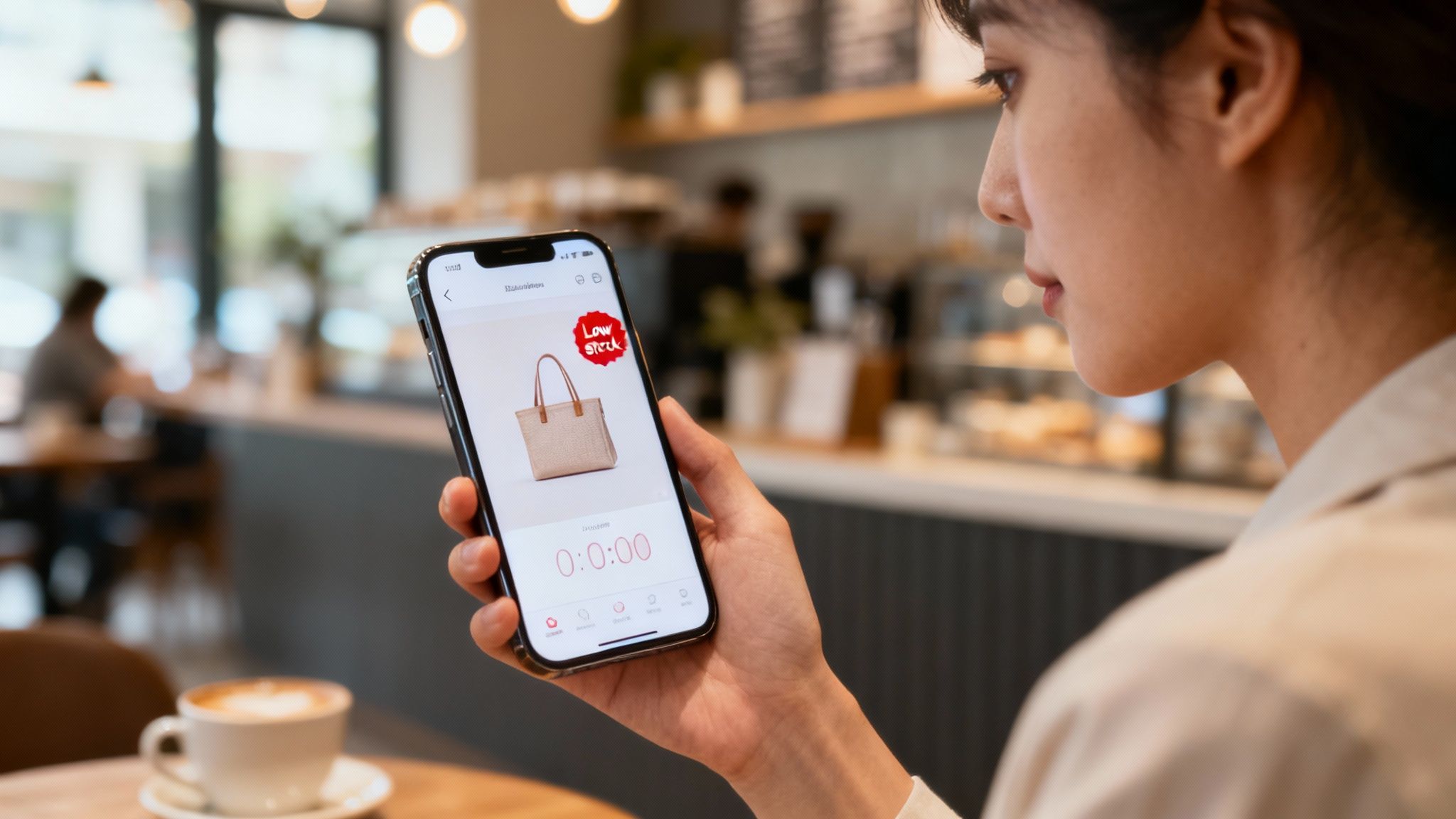
Strategic urgency marketing is not a gimmick—it's applied behavioral science. It’s about understanding the psychological drivers of human decision-making and using that knowledge to ethically accelerate a shopper's path to purchase. While a basic app can add a countdown timer to a page, a sophisticated approach taps into powerful principles from consumer psychology. The objective is to create genuine excitement and inspire immediate action, all while protecting your profit margins.
At its core, this strategy leverages a cognitive bias known as loss aversion. Behavioral economics research shows that humans feel the pain of losing something about twice as intensely as the pleasure of gaining something of equal value. This is where simple email popups often miss the mark; they offer a small gain (e.g., 10% off), but authentic urgency taps into the powerful fear of missing out (FOMO).
Instead of just showing a clock, a smart ecommerce marketing platform translates these psychological triggers into automated, revenue-generating "Moments" throughout the shopper journey.
Beyond Basic Timers: The Science of Influence
Effective urgency is about persuasion, not pressure. It moves beyond the blunt instrument of a generic timer to use more nuanced, scientifically-backed triggers to influence behavior. This is achieved by layering key psychological principles:
- Scarcity: Highlighting limited availability, such as "Only 10 left!" or "Offer ends tonight." Scarcity instantly increases a product's perceived value and provides a compelling reason to act now before the opportunity is lost.
- Social Proof: As social creatures, we look to others for cues. Displaying messages like "25 people have this in their cart" validates a shopper's interest, reduces hesitation, and builds a sense of communal excitement that a simple timer cannot replicate.
- Anticipation: Building excitement before a sale or product launch creates powerful pent-up demand. This reframes the purchase as an exclusive event, turning casual browsers into engaged fans who are primed to buy the moment the offer is released.
Actionable Takeaway: The goal is to create authentic "Moments" of high intent, not superficial pressure. By using these behavioral triggers, you can run campaigns that feel exclusive and exciting, driving conversions without resorting to margin-killing universal discounts. This positions urgency as sophisticated psychology, not manipulation.
Putting Psychology to Work for Your Business
When executed correctly, sophisticated urgency marketing directly impacts your bottom line. It helps clear slow-moving inventory by creating a demand spike and protects profits by allowing you to sidestep deep, site-wide sales.
Instead of a generic 20% off coupon for everyone, you can offer a time-sensitive, high-value reward to a specific segment of high-intent customers. This creates a surge in sales with minimal damage to your margins.
In today's mobile-first world, these real-time interactions are more crucial than ever. The modern ecommerce marketing platform uses technologies like AI and machine learning to power dynamic pricing and real-time personalization, turning these psychological insights into automated campaigns. You can dig deeper into how these technologies are shaping the industry by exploring research on e-commerce platform trends.
By understanding and applying these psychological drivers, you transform urgency from a simple tactic into a core component of your revenue strategy.
Integrating Advanced Urgency into Your Marketing

True urgency marketing isn't an isolated tactic; it's a powerful psychological layer that integrates directly with your core ecommerce marketing platform. Instead of running disconnected campaigns, you can build cohesive, automated "Moments" that engage shoppers when their purchase intent is highest. This is where specialized tools amplify what your existing tech stack can do.
For merchants on Shopify and Shopify Plus, this means linking an advanced urgency platform with the tools you already rely on—like Klaviyo for email and Attentive for SMS. This creates a powerful feedback loop where a shopper's on-site behavior instantly triggers a personalized message to their inbox or phone, guiding them toward conversion automatically. This moves far beyond simple popups that just capture emails; it's a system engineered to actively drive sales.
Activating Behavioral Triggers
The real ROI is unlocked when you use behavioral data to initiate automated campaigns. With the right automation, you can identify high-intent shoppers and deliver the perfect message at the perfect time—something impossible to do manually at scale.
Here’s a practical, step-by-step example for Shopify merchants:
- Define the Trigger: Target shoppers who’ve viewed a specific product more than twice in the last 48 hours but haven’t purchased. This is a classic signal of high interest combined with hesitation.
- Create the Urgency Moment: Automatically display a time-sensitive, limited-quantity offer for that exact product to this segment. This is not a generic coupon; it’s a personalized nudge grounded in real scarcity and social proof.
- Automate Multi-Channel Outreach: Simultaneously, trigger a flow in Klaviyo and your SMS platform. The message could be, "We noticed you looking. A special offer on the item you love is waiting for you for the next two hours."
- Track the ROI: Measure the direct revenue generated from this automated workflow, tying sales directly back to that specific urgency moment and proving its impact on your bottom line.
Actionable Takeaway: By focusing on behavioral triggers, you shift from broad, margin-damaging discounts to precise, profit-protecting incentives. This psychological targeting respects the customer's interest while directly impacting your inventory turnover and revenue.
Scaling with Intelligent Automation
Integrating urgency this way is a game-changer for enterprise merchants on Shopify Plus, who manage massive customer volumes daily. The ability to automate these highly segmented campaigns saves hundreds of hours and eliminates the human error inherent in manual campaign management.
This approach also enhances your customer acquisition channels. Social media platforms like Instagram and TikTok drive high-intent traffic to your site through paid ads. When those shoppers land, automated urgency moments ensure you convert that expensive traffic effectively, maximizing your return on ad spend. To learn more about how social commerce is shaping the market, you can explore the latest e-commerce growth statistics.
For a deeper dive into the nuts and bolts, read our guide on specific Shopify urgency tactics you can implement today.
Common Questions About Ecommerce Marketing Platforms
Navigating the world of ecommerce technology can be overwhelming. When choosing the right tools for your brand, getting clear answers is the only way to make a smart decision that helps you achieve your revenue goals.
Let’s clarify some of the most common questions. These answers should provide a better understanding of how a unified system—especially one enhanced with smart strategies like urgency marketing—becomes the backbone of a modern, profitable online store.
What Is the Difference Between an Ecommerce and Marketing Platform?
The distinction is best understood with an analogy.
Your ecommerce platform (like Shopify or BigCommerce) is the physical storefront. It's the foundation, walls, shelves, and checkout counter. It is the essential infrastructure required to operate online.
An ecommerce marketing platform, in contrast, is your entire sales and marketing team operating inside that store. They are responsible for attracting customers, understanding their needs, guiding them to the right products, and providing a compelling reason to purchase now. It's the engine that uses email, SMS, and intelligent on-site experiences to transform a passive product catalog into an active, high-conversion selling environment.
Is a Single Platform Better Than Using Separate Apps?
At first glance, patching together best-in-class apps seems like a flexible strategy. However, it nearly always leads to a major operational bottleneck: data silos.
When your email tool doesn't know what your SMS app just sent, or your pop-up form can't communicate with your loyalty program, you cannot create a cohesive customer journey. This results in a disjointed experience for your shoppers and frustrating manual work for your team as they try to connect the dots.
A unified platform breaks down those walls, pulling all customer data into a single, actionable profile.
Actionable Takeaway: This unified view is the key to unlocking powerful, behavior-based automation and segmentation. The efficiency gains and performance lift from a single source of truth make a unified ecommerce marketing platform the smarter, more profitable choice for scalable growth.
How Does Urgency Marketing Fit into a Larger Strategy?
Urgency is not a gimmicky countdown timer. When used strategically, it’s a psychological accelerator that integrates with your entire marketing ecosystem. It is built on proven principles from behavioral economics, such as scarcity (limited quantity) and loss aversion (the fear of missing out).
This creates specific "Moments" of high intent that give customers the nudge they need to move from consideration to conversion.
Instead of being an isolated pop-up, it becomes a powerful, automated tool when integrated with your email and SMS channels through your main platform. This allows you to build massive hype for a product launch, clear seasonal inventory without resorting to profit-killing discounts, or re-engage high-intent shoppers who abandoned their carts. It's an approach that protects your margins while driving immediate, tangible revenue.
Ready to see how intelligent urgency can transform your marketing strategy? Learn how Quikly integrates with your platform to create high-impact, revenue-generating moments. Explore Quikly today.

The Quikly Content Team brings together urgency marketing experts, consumer psychologists, and data analysts who've helped power promotional campaigns since 2012. Drawing from our platform's 70M+ consumer interactions and thousands of successful campaigns, we share evidence-based insights that help brands create promotions that convert.
